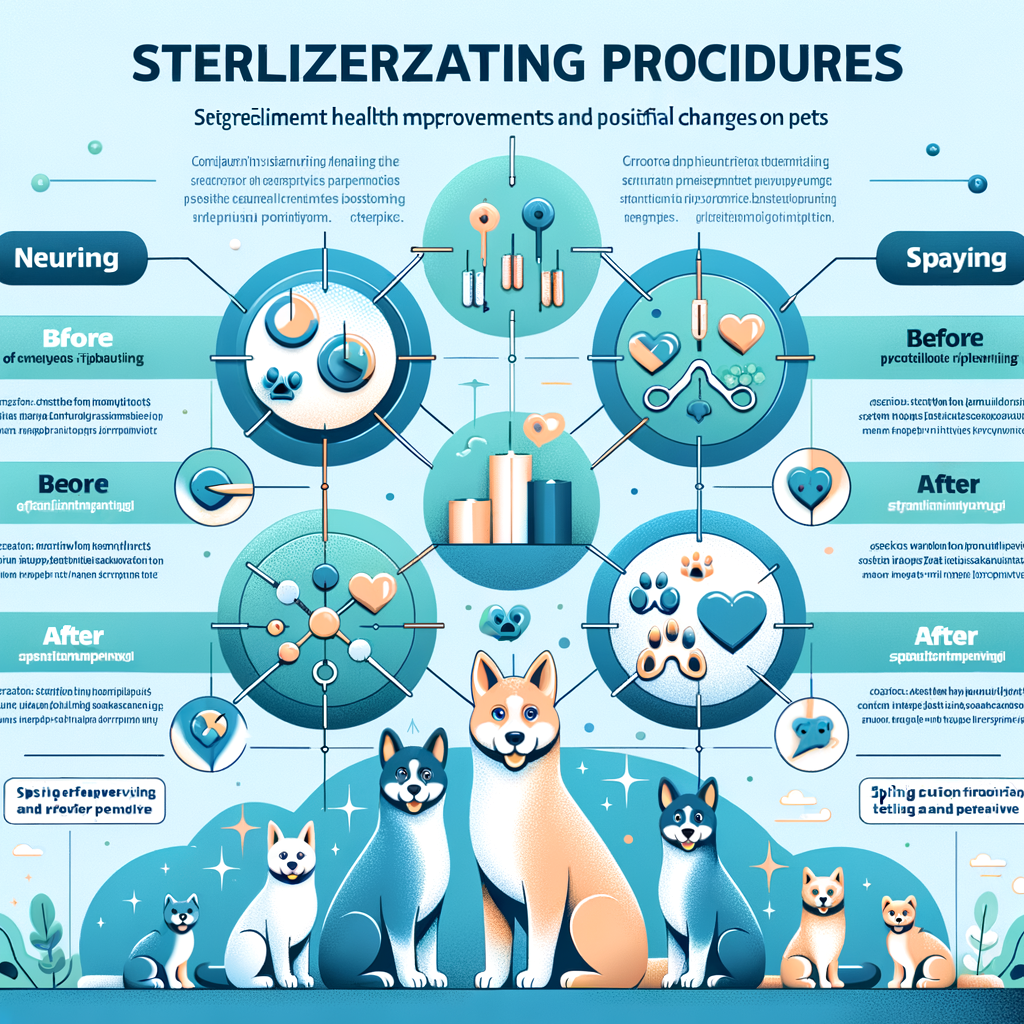
Introduction: The Importance of Neutering/Spaying
When it comes to pet care, one of the most important decisions you can make for your furry friend’s health and well-being is to have them neutered or spayed. This simple procedure can have a profound impact on their lives, and yours too. Let’s delve into the world of neutering and spaying to understand its importance.
- Understanding neutering and spaying
- Why neutering/spaying is important
Neutering and spaying are surgical procedures performed by a veterinarian to prevent pets from reproducing. Neutering refers to the removal of male pets’ reproductive organs, while spaying involves the removal of female pets’ reproductive organs. These procedures are typically performed when the pet is young, but can be done at any age.
There are several reasons why neutering or spaying your pet is important. Firstly, it helps control the pet population. Millions of unwanted pets end up in shelters or on the streets each year. By neutering or spaying your pet, you can help reduce this number.
Secondly, neutering or spaying can improve your pet’s health and behavior. Neutered pets are less likely to roam, fight, or mark their territory, and they have a lower risk of certain types of cancers. Spayed pets won’t go into heat, which can be a stressful and uncomfortable experience for them.
Lastly, neutering or spaying can save you time, money, and stress in the long run. Unneutered pets can cause damage or become aggressive, and caring for a pet with health problems or a litter of puppies or kittens can be expensive and time-consuming.
In conclusion, neutering or spaying is a responsible and beneficial choice for pet owners. It’s a simple procedure that can make a big difference in the life of your pet and the community. Stay tuned as we delve deeper into the benefits of neutering and spaying in the following sections.
Benefits of Neutering Pets
Neutering pets is a responsible choice that pet owners can make for the welfare of their furry friends. This procedure not only helps control the pet population but also brings several health and behavioral benefits. Let’s delve into some of the significant health improvements that neutering can offer.
Health Improvements from Neutering
Neutering, or the removal of a male pet’s testicles, can lead to substantial health benefits. Here are some of the most notable ones:
- Reduction in Risk of Certain Diseases
- Increased Lifespan
- Improved Overall Health
Neutering significantly reduces the risk of certain diseases in pets. For example, it eliminates the chances of testicular cancer, a common ailment in unneutered dogs and cats. It also reduces the risk of prostate disorders, which can lead to uncomfortable and potentially dangerous health issues.
Studies have shown that neutered pets tend to live longer than their unneutered counterparts. This is likely due to the reduced risk of diseases and the decreased likelihood of roaming and getting into dangerous situations.
Neutering can improve a pet’s overall health and quality of life. Neutered pets are generally calmer and less prone to behavior-related health issues like stress and anxiety. They are also less likely to engage in risky behaviors, such as fighting or roaming, which can lead to injuries or exposure to diseases.
In conclusion, neutering is a beneficial procedure that can significantly enhance your pet’s health and longevity. It’s a responsible choice that can lead to a happier, healthier life for your pet.
Behavior Changes After Neutering
Neutering your pet can lead to significant changes in their behavior. This can be a positive shift, especially for pet owners who may be dealing with aggressive or territorial pets. Let’s explore some of these behavior changes in more detail.
- Decrease in Aggression
- Reduced Territorial Behavior
Aggression in pets can be a serious problem, causing stress for both the pet and the owner. It can lead to biting, scratching, and other harmful behaviors. After neutering, many pet owners notice a significant decrease in their pet’s aggression. This is because the procedure reduces the production of testosterone, a hormone that can contribute to aggressive behavior. This can make your pet calmer and more manageable.
Territorial behavior is another common issue in pets. This can include behaviors like marking territory (especially in cats), or becoming overly protective of certain areas or people. Neutering can help reduce these behaviors. Without the influence of certain hormones, pets are less likely to feel the need to mark their territory or act aggressively to protect it. This can lead to a more peaceful home environment for everyone involved.
Remember, every pet is unique and may react differently to being neutered. However, these behavior changes are commonly observed and can greatly improve the quality of life for both pets and their owners. It’s always important to consult with a trusted veterinarian to understand the potential impacts and benefits of neutering your pet.
Advantages of Spaying Animals
Spaying is a common veterinary procedure that has numerous benefits for our beloved pets. It not only helps control the pet population, but also brings about significant health and behavioral benefits. Let’s delve into the health advantages of spaying your pets.
Health Benefits of Spaying Pets
Spaying your pet can lead to a healthier, longer life. Here are two key health benefits:
- Prevention of Certain Health Issues
- Increased Lifespan
Spaying helps prevent several health problems, particularly those related to the reproductive system. For instance, it can prevent uterine infections and breast tumors, which are malignant or cancerous in about 50 percent of dogs and 90 percent of cats. Spaying your pets before their first heat offers the best protection from these diseases.
Spayed animals often live longer, healthier lives. According to a study by the American Veterinary Medical Association, spayed female dogs live 23% longer than unspayed female dogs. The lifespan of spayed cats is also significantly longer. This is largely due to the reduced risk of developing certain diseases after spaying.
Spaying is a responsible and beneficial choice for your pet’s overall health. It not only prevents certain health issues but also contributes to a longer, healthier life for your pet. Remember, a healthy pet is a happy pet!
Impact of Spaying on Behavior
Spaying your pet can have a significant influence on their behavior. This procedure can lead to a decrease in unwanted behaviors and an improvement in social behavior. Let’s delve deeper into these changes.
- Decrease in Unwanted Behaviors
- Improved Social Behavior
After a pet is spayed, you may notice a reduction in certain behaviors that can be challenging to manage. For instance, female pets often exhibit signs of restlessness and aggression during their heat cycles. They may also attract unwanted attention from male animals, leading to noise and potential fights. Spaying eliminates these heat cycles, thereby reducing these behaviors.
Spaying can also lead to improved social behavior in pets. Animals that have been spayed are often calmer and less aggressive, making them easier to handle and more enjoyable to be around. They are less likely to engage in territorial marking or fighting with other animals. This can make social situations, such as visits to the park or interactions with other pets, more pleasant for everyone involved.
In conclusion, spaying can have a positive impact on your pet’s behavior, making them more manageable and sociable. It’s one of the many benefits of this procedure, alongside the health advantages we discussed earlier. Remember, a happier pet leads to a happier home!
Pet Health and Neutering
Neutering is not just about controlling the pet population. It also plays a significant role in maintaining the overall health of your pets. Let’s delve into a case study and key takeaways that highlight the health benefits of neutering.
-
Case Study: Health Improvements in Neutered Pets
Consider the case of Max, a Labrador Retriever. Before being neutered, Max was often aggressive, prone to wandering, and had a higher risk of developing certain health issues. After neutering, not only did his behavior improve, but his risk for testicular cancer and prostate problems was eliminated. This is not an isolated case. According to the American Veterinary Medical Association, neutered pets are generally healthier and have a longer lifespan.
-
Key Takeaways: How Neutering Contributes to Pet Health
Neutering contributes to pet health in several ways:
- Prevents Diseases: Neutering eliminates the risk of testicular cancer and significantly reduces the risk of prostate disease in male pets.
- Reduces Aggression: Neutered pets are less likely to display aggression or engage in fights, reducing the risk of injuries.
- Prevents Roaming: Neutered pets are less likely to roam, reducing the risk of accidents or getting lost.
- Increases Lifespan: On average, neutered pets live longer than those that are not neutered.
In conclusion, neutering is a responsible and beneficial choice for your pet’s health. It not only helps control the pet population but also contributes significantly to the overall well-being of your furry friend.
Pet Behavior After Neutering
After neutering, pets may exhibit a range of behavior changes. Understanding these changes can help pet owners better care for their pets and ensure their wellbeing. Let’s delve into some examples of these behavior changes and why they occur.
- Examples of Behavior Changes
- Decreased Aggression: Neutering often reduces aggressive behavior in pets, especially males. This is because the procedure lowers testosterone levels, which is linked to aggressive tendencies.
- Reduced Roaming: The desire to roam is often driven by a pet’s instinct to find a mate. Neutering eliminates this urge, leading to less roaming and a safer environment for your pet.
- Increased Appetite: Some pets may experience an increase in appetite after being neutered, which can lead to weight gain if not managed properly.
- Change in Activity Levels: Some pets may become less active after neutering, while others may remain as active as before. It varies from pet to pet.
- Understanding Why Behavior Changes Occur
Post-neutering, pets may display a variety of behavior changes. These can include:
Behavior changes after neutering are primarily due to alterations in hormone levels. Neutering involves the removal of certain reproductive organs, which significantly reduces the production of hormones like testosterone in males and estrogen in females. These hormones play a significant role in influencing pet behavior.
For instance, testosterone is linked to aggression and territorial behavior in male pets. When the production of this hormone decreases post-neutering, such behaviors often diminish. Similarly, the reduction of estrogen in females can lead to less anxious and more docile behavior.
It’s important to note that while neutering can influence behavior, it’s not a guaranteed fix for all behavioral issues. Other factors, such as training, socialization, and environment, also play a crucial role in shaping your pet’s behavior.
Neutering and Spaying Benefits: A Summary
Neutering and spaying are essential procedures that contribute significantly to the health, behavior, and overall well-being of pets. In this section, we will summarize the key benefits of these procedures.
- Health Benefits
- Behavioral Benefits
- Impact on Pet Population
Neutering and spaying can help prevent various health issues in pets. For instance, these procedures can reduce the risk of certain types of cancers. In male pets, neutering eliminates the risk of testicular cancer, while in females, spaying before the first heat cycle can significantly reduce the risk of mammary gland tumors, which are often malignant or cancerous.
Behavioral changes are another significant benefit of neutering and spaying. Male pets, once neutered, are less likely to roam away from home in search of a mate, reducing the risk of accidents or fights with other animals. They also become less aggressive and more focused, making them easier to train. Female pets, once spayed, will not go into heat, eliminating behaviors such as yowling, frequent urination, and attracting unwanted male pets.
Neutering and spaying also play a crucial role in controlling the pet population. Millions of unwanted pets end up in shelters or on the streets each year. By neutering and spaying your pets, you can contribute to the solution of this problem by preventing unplanned litters, thus reducing the number of animals who need to find homes.
In conclusion, neutering and spaying offer a range of benefits, from improved health and behavior to a positive impact on the pet population. As responsible pet owners, it’s crucial to consider these procedures to ensure the long-term well-being of our furry friends.
Conclusion: Transform Your Pet’s Life
As we conclude this informative journey, we revisit the critical aspects of neutering and spaying, and the profound impact they can have on your pet’s life. The decision to neuter or spay your pet is not just a responsible choice; it’s a life-changing one that can significantly improve the health and behavior of your beloved companion.
-
Revisiting the Importance of Neutering/Spaying
Neutering and spaying are more than just preventive measures for unwanted litters. They play a significant role in enhancing your pet’s overall health and longevity. Neutering helps prevent testicular cancer and prostate problems in male pets, while spaying eliminates the risk of uterine infections and breast tumors in females, which are malignant or cancerous in about 50% of dogs and 90% of cats. These procedures also help curb aggressive behavior, marking territory, and the urge to roam, making your pet more docile and manageable.
-
Final Thoughts on the Health and Behavior Benefits
The health and behavior benefits of neutering and spaying are undeniable. Pets that undergo these procedures tend to live longer, healthier lives. They are less likely to develop certain types of cancers and are generally more behaved. They are less likely to run away from home, get into fights, or become aggressive. In essence, neutering and spaying can transform your pet’s life, making them healthier, happier, and more content.
As pet owners, our primary responsibility is to ensure the well-being of our furry friends. Neutering and spaying are crucial steps in fulfilling this responsibility. So, let’s make the right choice for our pets, for their health, their behavior, and their overall quality of life.




